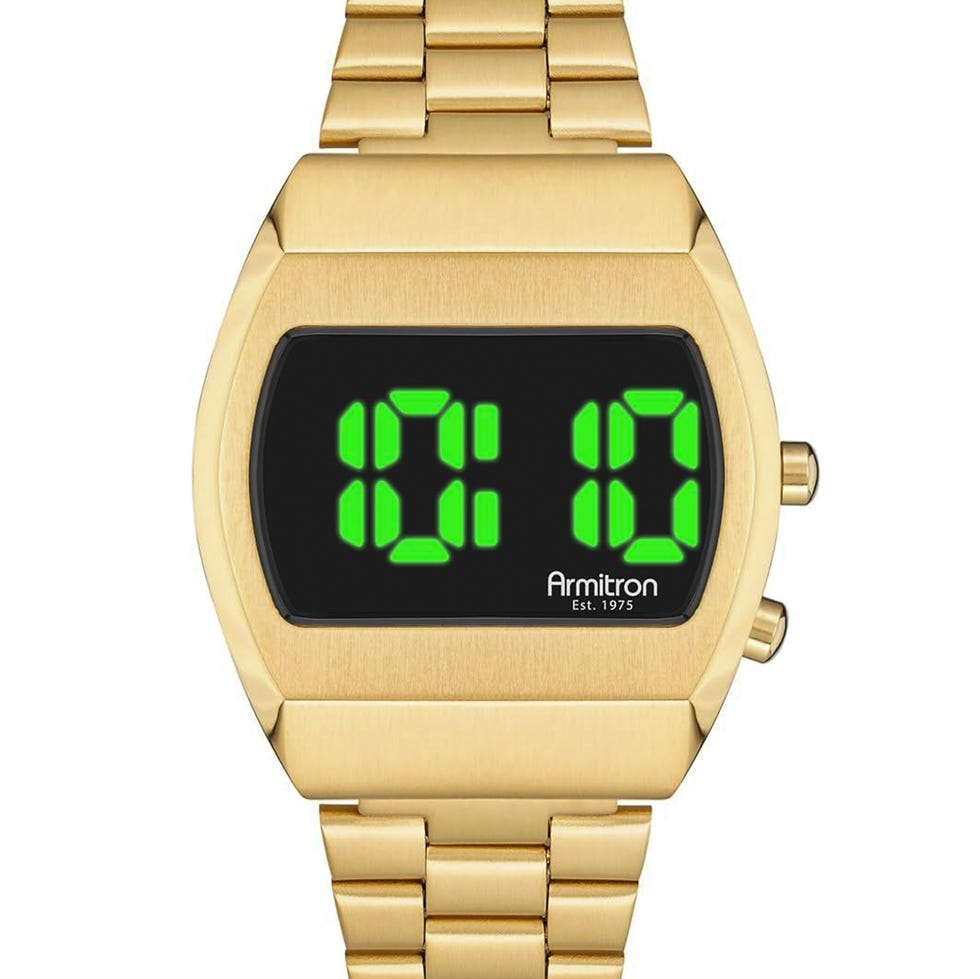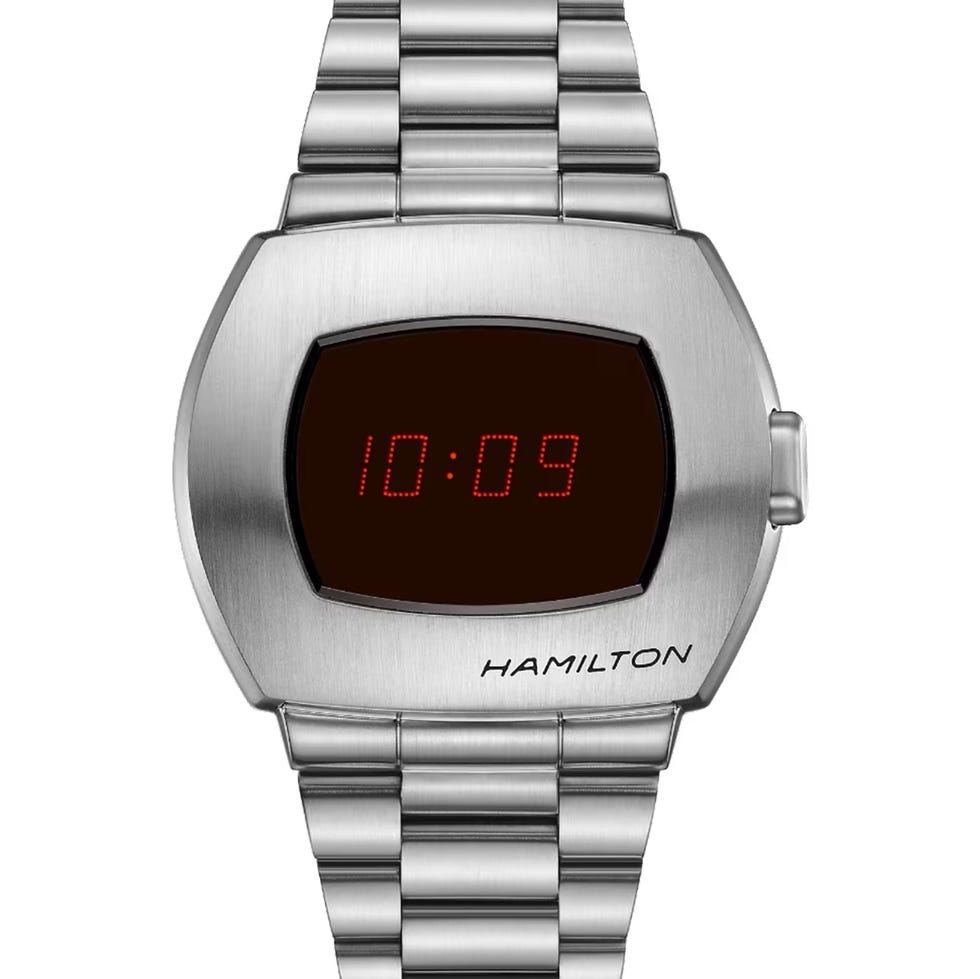The Definitive Guide to Digital Watches

For the love of Switzerland, hold in your rage for a moment and hear us out: There are occasions upon which batteries are superior to springs. There—we said it!
We know, we know: No small part of the watch-collecting hobby revolves around the beauty and wonder of the mechanical movement, that carefully choreographed dance of gears and springs driven by nothing but kinetic energy and ingenuity. This movement type—with its refined coordination of escapement, gear train, mainspring, regulator, et al—never ceases to induce wonder…and why should it? It’s truly the pinnacle of man-made mechanical art.
Then again, it’s not always the right tool for the job. There are certain situations in which a quartz watch—one in which energy from a battery is passed through a quartz crystal that oscillates at a fixed frequency in order to drive the movement’s gears—is more appropriate than a mechanical one. Furthermore, there are certain situations in which an analog dial isn’t necessarily optimal at all, and a digital one is more appropriate.
Take the military, for example: Soldiers these days aren’t (for the most part) issued watches at all, but they are often instructed to purchase a simple digital watch such as a Casio G-Shock. Why? Basic training is a torturous period during which one’s time isn’t one’s own—it belongs to one’s commanding officer. Thus a digital watch is necessary for setting all kinds of countdown timers and stopwatches. (Try timing short intervals on an analog watch and you’ll quickly see why it’s far from optimal.)
Far at the opposite end of the professional spectrum of military and law enforcement use, digital watches are also an excellent choice for kids, who are able to quickly and easily discern the time from their pixel-filled screens. (Plus, who doesn’t love a light-up LCD and an object with a bunch of buttons to push?) The cases of these watches are often colorful and paired with similarly flamboyant straps, which also gets you some additional points with the young-uns. Plus, they’re cheap: Whether in a professional application or on your eight-year-old’s wrist, a destroyed $80 digital watch is much less of a cause for alarm than a busted Omega.
Digital watches aren’t just for soldiers and elementary schoolers, of course. There are also numerous digital watches with significant horological bona fides and provenance that can be enjoyed by everyday watch enthusiasts: Armitron, which is celebrating 50 years of business, still makes modern versions of its early LCD watches, as does Hamilton with its light-up Pulsar, the world’s first all-electronic digital watch. Girard-Perregaux likewise continues to manufacture its Casquette, and a Casio Databank can be had on Amazon for about $60 on Amazon. Due to the continued interest in heritage designs, many of the classic early digital watches are thus still on the market. And don’t get us started on G-SHOCK: There are collectors out there with hundreds (or thousands) of models in their watch box. And who can blame ‘em—in a stuffy world, these tough, affordable pieces are downright fun.
From $40 Casios to high-end GPs, check out some of our favorite digital timepieces below.
Timex Ironman
SPECS:Diameter: 38mmWater Resistance: 100mNotable Features: 100-hour chronograph with 30-lap memory; 24-hour countdown timerPrice: $31MORE INFO
Famously worn by President Bill Clinton, the Timex Ironman occupied the place of the modern G-SHOCK in the 1980s and ‘90s: Developed for triathlon athletes, it features a wide array of chronographs, alarms, lap timers, and other features. Timex’s Indiglo backlight technology was added in 1992—along with increased water resistance of 100m, this made for a distinctively sporty digital watch at an affordable price. These days, the Ironman is available in a wider array of configurations than ever before, including dedicated ladies’ models as well as oversized versions. Most of these can be had for under $50, making for a widely available, affordable, tough-as-nails tool watch with a bright, easy-to-read digital display.
Armitron Griffy
SPECS:Diameter: 37mmWater Resistance: 50mmNotable Features: Light-up LCD screen; wide variety of available colorsPrice: $38MORE INFO
Founded in 1975, Armitron made digital watches during the heyday of the LED screen, updating to LCD technology and using Japanese-made quartz movements throughout the 1980s. Today, the relaunched brand continues to make affordable quartz timekeepers of both the analog and digital variety, with its Griffy being particularly notable for its retro looks and wide variety of available case colors. Similarly to the Hamilton PSR, it features a tonneau-shaped steel case and matching bracelet, plus a light-up LCD screen that can easily be activated using a side button. With 50m of water resistance, it’s yet another excellent choice for kids, though adults will surely appreciate its throwback looks and easy-to-read screen just as much.
Casio G-SHOCK DW6900-1V
SPECS:Diameter: 50mmWater Resistance: 200mNotable Features: Alarm; world time; countdown timer; light-up screenPrice: $40MORE INFO
It’s difficult to imagine a wristwatch in any category with more bang for your buck than the humble G-SHOCK—particularly those in the DW6900 series. Boasting all manner of alarms, stopwatches, world timers, countdown timers, and 200m of water resistance, this comfortable resin-cased tool is incredibly comfortable on its rubber strap. Furthermore, it can take an absolute beating—which is probably why it’s the choice of soldiers and law enforcement personnel the world over. With its light-up LCD screen, four-button array, and black case and band, it flies right under the radar, which is exactly what you want when traveling in some of the world’s more out-of-the-way locations. The best part? The price—at well under $100, it’s an absolute steal.
Casio Databank
SPECS:Diameter: 37.4mmWater Resistance: 30mNotable Features: Calculator; information storagePrice: $61MORE INFO
The Casio Databank, released in 1983, is not only a digital watch classic, but also the world’s first calculator watch. Throughout the years, numerous special features were added that allowed the wearer to store phone numbers, schedule information, voice recordings, and more—this, furthermore, was in addition to the model’s vast timekeeping capabilities, which includes world time, stopwatches, and alarms. With the advent of the smartphone in the early 2000s, the Databank lost its futuristic appeal. However, the model has made a comeback lately as a sort of fashion statement, its built-in keyboard and compact proportions gaining it some retro points among the fashion set.
Apple Watch Series 10
SPECS:Diameter: 42mm or 46mmWater Resistance: 50mNotable Features: Available cellular connectivity; always-on Retina displayPrice: $399+MORE INFO
Since its debut in 2015, millions of people around the world have adopted the Apple Watch as their timepiece of choice—and for good reason: With its plethora of health- and fitness-related functions; ability to take calls and send messages; good looks; and Dick Tracy-like sense of futurism, this sleek communications device is tough to ignore. Indeed, to simply call the Apple Watch a “watch” is to sell it distinctly short, though it can of course keep excellent time—in fact, it can imitate the analog dials of numerous vintage watches, giving one a sort of horological art installation-cum-museum on one’s wrist. As far as digital watches go, there is perhaps no other model from any brand that is more capable or more representative of the horological frontier.
Hamilton American Classic PSR
SPECS:Diameter: 35mmWater Resistance: 100mNotable Features: Light-up LCD-OLED displayPrice: $845MORE INFO
The world’s first LED watch debuted (as a prototype) way back in 1970 on The Tonight Show with Johnny Carson. Developed not by a Japanese conglomerate but, surprisingly, by Hamilton, it was a decidedly futuristic, Space Age piece of kit—although unfortunately, it was quickly made obsolete by the advent of the LCDs and the proliferation of less expensive digital watches from the likes of Texas Instruments. (Seiko would eventually buy the Pulsar division and continue to produce watches under this name.) Today, Hamilton (now owned by Swatch Group) makes a reissue of the original Pular called the PSR. Available in various case colors, it features a cool crown button that lights up the screen on demand as well as a neat integrated bracelet.
Casquette 2.0
SPECS:Diameter: 33.6mmWater Resistance: 50mNotable Features: Grade 5 titanium case; chronograph and second time zonePrice: $7,500MORE INFO
Introduced at the Basel Watch Fair in 1976, the Casquette combined then-revolutionary LED technology with a unique angled case that was ideal for drivers. Taking aesthetic inspiration from period muscle cars, its sloping frame and integrated bracelet made it unique amongst digital watches—which is probably why Girard-Perregaux decided to reintroduce it in 2022 during the boom in heritage-inspired watchmaking. Today, the Casquette 2.0 is powered by the brand’s Calibre GP3980, which adds month, date, year, second time zone, and a secret date display functionality. Available in a variety of materials from titanium to gold, it’s an excellent premium option for someone who desires a more high-end digital watch.
esquire




